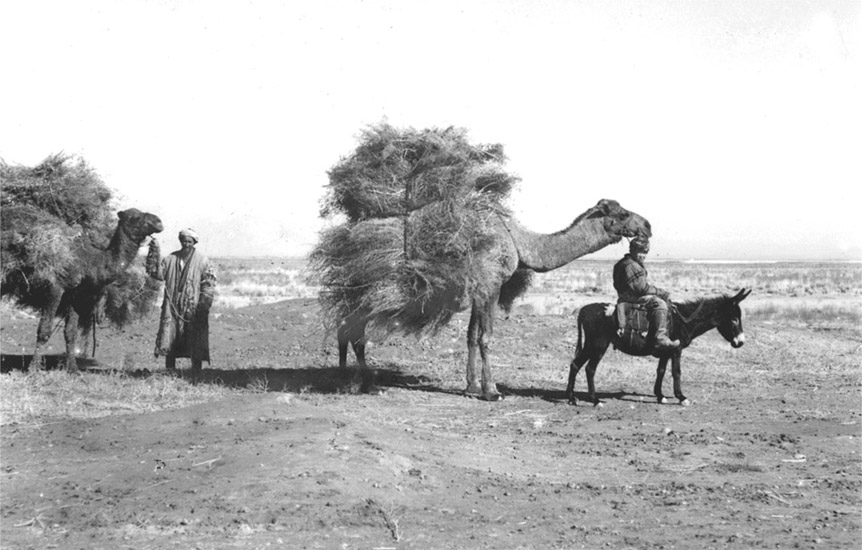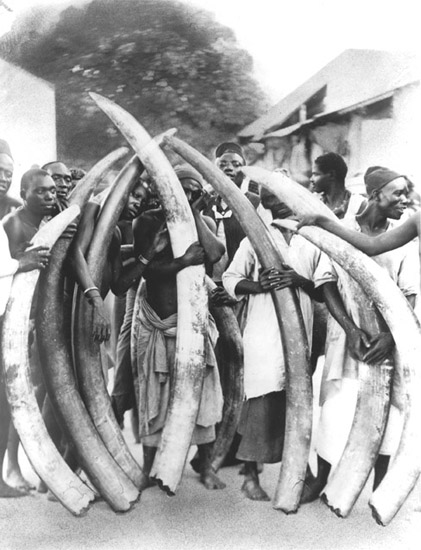Animals have been used to transport goods from one location to another since the beginning of time. As the trade routes developed and ex panded, camels became the beast of choice. Capable of covering large distances with few stops for food and water, they were ideally suited for travel across the deserts of North Africa, Central Asia, and the Middle East, where there was a lack of navigable rivers. Camels can travel up to nine days without water and even longer without food, but then they must rest for up to a month after the journey to replenish the fat stored in their humps. Normally, caravans traveled between thirty-five and fifty-five days to reach their destinations.
In grassy regions, the primary animals of transport were horses, mules, or donkeys. These animals were ideally suited for rugged terrain but were also used on the plains areas where carts or wagons allowed the transport of bulk items over shorter distances. The transport of large groups of people usually occurred on horses.
Animals were not only beasts of burden, but were also highly prized commodities themselves. Camels, for instance, were bred in the Middle East and sold to outlaying areas in Africa and Central Asia. Horses have always been valuable. In Europe, the noble class owned horses, while other cultures such as the American Indian, after the introduction of the horse to the New World, and the Mongols valued the horse as a means of transportation as they migrated over vast areas. In the United States, the horse was so valuable that horse theft was punishable by hanging.
Other animals that were traded from one region to another included the more exotic species. Leopards and cheetahs from Africa were sold to the pharaohs. Elephants from India, Asia, and Africa were sold to the Romans. Merchants from the Far East even carried silk worms to Constantinople, where the government established silk factories during the Middle Ages.
Records as to the number of animals slaughtered for their fur do not exist from the ancient or medieval periods, but sources do indicate that the trade was substantial. The market for furs provided the incentive for the French to establish trading posts in the New World, where Indians exchanged the pelts for items such as glass beads, whiskey, or metal objects. Although the French did not settle large numbers of colonists in Canada and the Ohio Valley region, the trade was profitable enough to fight the British colonists over possession of the area. The Dutch also established trading posts in New Netherlands (later renamed New York), as did the Swedes in New Sweden (later renamed Delaware) for furs. The English conquered both of these colonies in 1664 and 1681, respectively.
As hunters moved further into the interior of the North American continent, they began trapping foxes, coyotes, raccoons, badgers, minks, and rabbits as well as beaver. Bison became the animal of choice (for their hides and tongues) for hunters as the railroads spread across the Great Plains. In the early 1800s, approximately 65 million bison roamed throughout North America, but extensive hunting of this animal reduced its numbers to 1,000 by 1890. In an effort to protect the species, the U.S. Congress passed the Lacey Act in 1894, which imposed a $1,000 fine on anyone who shot a bison. By 2000, the number of bison had increased to 300,000 in the United States and Canada, and that number is expected to quadruple by 2010.

Capable of covering large distances with few stops for food and water, camels were ideally suited for travel and trade across the deserts of North Africa, Central Asia, and the Middle East, where there was a lack of navigable rivers. Depicted here is a camel caravan carrying thorns for fodder on the Golodnaya Steppe. (Library of Congress)
The same problem of overhunting occurred in the late 1800s and 1900s in other regions. In Africa and Central Asia, elephants were hunted just for their ivory tusks. In many countries, the killing of elephants has been prohibited. Even though large national preserves serve to protect many of these animals, poachers still continue to kill them, because the price of the ivory outweighs the risk of being caught and fined.
The fur industry has remained an important sector in international trade throughout the twentieth and early twenty-first centuries. Sixty-five percent of animals used for furs are raised on fur farms in northern Europe and 13 percent in North America. Other countries that produce furs are Argentina, the Baltic States, China, Russia, and the Ukraine. These furs are auctioned at one of the large auction houses in Copenhagen, the Netherlands; Helsinki, Finland; Oslo, Sweden; Saint Petersburg, Russia; Seattle, Washington; or Toronto, Canada. In 2001 and 2002, the amount brought by furs sold totaled $11 billion. Fur is Denmark’s third largest export. In Finland, 50 percent of the farmers rely on the fur trade as their only source of income. Clothing manufacturers in Hong Kong export over $230 million in fur every year. In North America, the fur trade contributes $1.5 billion to the U.S. economy and $800 million to the Canadian economy. Although some animal rights organizations have attempted to end the use of fur, sales since 1997 have actually increased.
Cynthia Clark Northrup
See also: Caravans; Donkeys; Pegolotti, Francesco Balducci; Silk Road.
Bibliography
Becker, John E. The North American Bison. San Diego: Kidhaven, 2003.
Thompson, John. Carts, Carriages, and Caravans. Fleet, UK: J. Thompson, 1980.
Wellard, James Howard. Samarkand and Beyond: A History of Desert Caravans. London: Constable, 1977.

